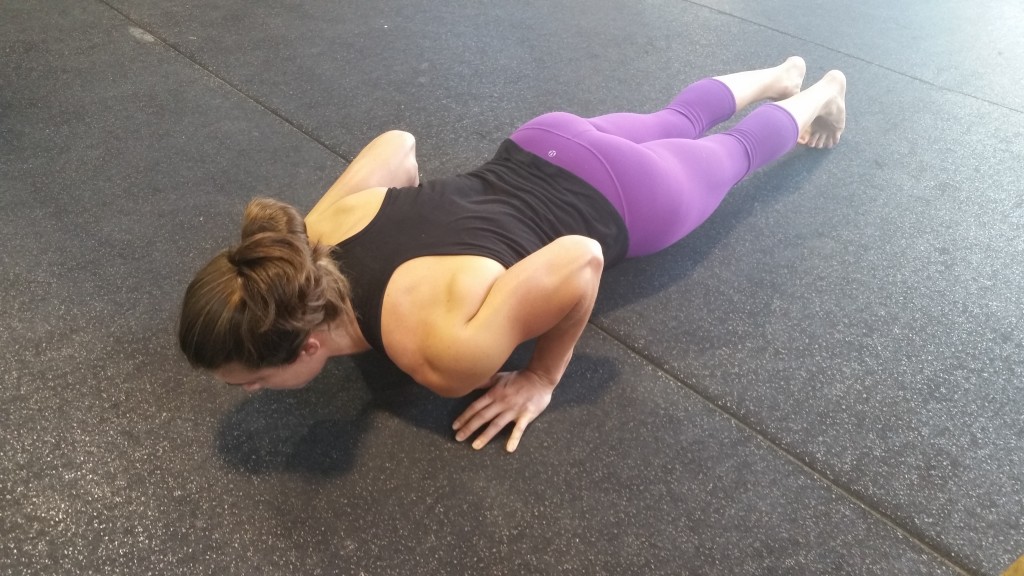
Push-Up Technique: Protection is Essential
Written by Melissa Hurley
The push-up can go anywhere with you – it’s one of the staple movements of the fitness world.
But, are you doing it correctly or are you putting your body in a potentially harmful position when doing this movement?
Though the push-up is “just” a bodyweight movement, force is still being applied, and, if your body is in an improper position, injury can happen. Are you getting the most out of your push-ups and keeping your body safe?
Here’s how to perform the perfect standard push-up!
Hand Position – Internal rotation of the hand position during the push-up leads to greater posterior and varus forces on the elbow joints which can produce injurious shear forces. Internally rotated hand position should be avoided for optimal elbow health.
Elbow Position and Arm Angle – Research shows that narrow base push-ups lead to higher electrical activity in the muscles (EMG values) in both the triceps brachii and pectoralis major than in a wide base push-ups. Got elbow issues? Studies found that peak axial forces on the elbow joint during push-ups averaged around 45% of body weight. This increases to 75% in the case of narrow base push-ups. If you can keep your forearm vertical with no angle you can decrease the force. Your elbow should stay stacked over your wrist throughout the entire movement, making a 90’ angle at the elbow. Bringing your elbows in towards the body will also put less stress on your shoulder joint. By doing push-ups with your elbows closer to your sides, you strengthen the serratus anterior muscles (muscles at the sides of your chest). The serratus anterior attaches to your shoulder blade and helps stabilize the joint. You can maximize your ability to create force and get better leverage with each rep by keeping the elbows close to your sides at roughly a 20 to 40 degree angle from your body. This shortens the lever arm, which gives you an immediate mechanical advantage when doing push ups.
Shoulder Position – I can’t stress enough here – proper posture, proper posture, proper posture! Keep as much distance between the shoulders and your ears as possible. Keeping your shoulders down away from your ears can help protect the shoulder joint and yield the greatest strength output. So how do you ensure your shoulders are locked down properly and your lat (latissimus dorsi) muscles are contracted? If you think about pulling the floor toward you as you lower down to the ground and twist your palm into the ground, adding torque, it will help engage the lat muscles to stabilize your shoulder. When your lat muscle underneath your shoulder is contracted, it immediately pulls your shoulder back and down away from your ears, which makes your very mobile shoulder much more stable.
Keep progressing your push-ups, but focus on these upper body mechanics. There are many variations to help you reach your goals. But, with anything, first and foremost, your focus should be on having a safe, solid form. The above article only covers the upper half of the push-up. Stay tuned for more focus points to perfect your push-up form on the lower half.
References:
Paul Pei-Hsi Chou. Effect of Push-up Speed on Elbow Joint Loading. Journal of Medical and Biological Engineering, 31(3): 161-168 161. Received 1 Apr 2010; Accepted 14 Jun 2010; doi: 10.5405/jmbe.772
Andersen, Lars L. Muscle Activation during Push-Ups with Different Suspension Training Systems. Journal of Sports Sci Med. 2014 Sep; 13(3): 502–510. Published online 2014 Sep 1.
Snarr, Ronald L. and Esco, Michael R. Electromyographic Comparison of Traditional and Suspension Push-Ups. Journal of Human Kinetics. 2013 Dec 18; 39: 75–83.
Hi – could you do a progression to a perfect pushup on the blog? I see all the same things when I google it (i.e., knee pushups, wall pushups, etc) but I don’t feel like it translates into a “perfect standard pushup” for me. What other exercises would help build strength?
My elbow clicks when I do push ups and although it’s not painful it’s unsettling for me and I can avoid it by doing a wide hand placement with my fingers pointing inward slightly. So I don’t know…I’ve received tips from the coaching staff about moving my hands under my shoulders on more than one occasion.